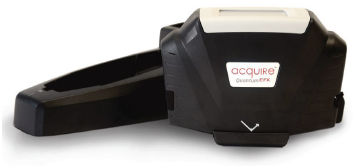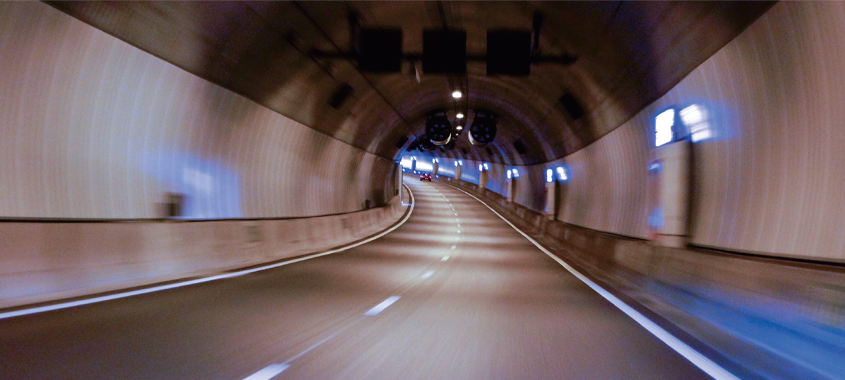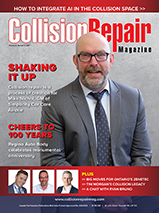TO 2022 AND BEYOND
FROM PAINT MATERIALS TO IMPROVED ADAS AWARENESS, THERE’S A LOT IN STORE FOR THE CANADIAN MARKET
By Allison Rogers and Max Reid
With the events of the last 18 months considered, the only direction to look for the future is upward. If there is one sentiment any veteran collision repairer stands by, it’s the fact that the last five years have delivered more disruption and change than the previous 20 years combined. Imagine the possibilities the next five years, not to mention the next 10, or 20.

Here are a few of the aspects Canada’s collision repairers are anticipating, according to Collision Repair mag’s sources.
Mixin’ it Up
Recall the shockwaves felt in bodyshops across North America when Ford announced the aluminum F-150, back in 2015? Well, there could be more substrate switches of the eco-conscious variety in the future for the vehicles of tomorrow.
At the end of 2020, the Canadian government announced a $1.2 million pour into Green Nano Technologies for its research into wood-fibre composite use for automotive parts. In a similar, eco-friendly vein, Leamington, Ontario-based Competitive Green Technologies (CGT) has a partnership with Ford and McDonald’s; the green minds at CGT take coffee waste from McDonald’s and use a patented process to transform it into resin for car parts.
With the over-arching goal of minimal collision damage in mind, automakers are also turning their sights to carbon fibre car parts. Touted as a lighter, stronger alternative to steel and even aluminum, luxury automakers, in particular, are keen to incorporate the material in their models to add that certain wow factor. McLaren even incorporated a carbon fibre chassis in its Elva model in 2019. While luxury makes are not the everyday repairer’s frequent find—the Elva literally has no windshield, making it pretty impractical and unattainable for the everyday commuter—such ideas could one day trickle down to average light vehicles.
The Path to Paint Perfection
The paint matching technology of 2021 is far from the thick and weathered colour flipbook that sat poised on your desk through the ’80s. With today’s spectrophotometers in tow, you’ll rarely run into a colour matching nightmare; but that’s only if you know what you’re doing.
The sophisticated spectrometers of today feature a colour camera that captures multiple colour images of the car’s surface. The images taken will then be used to identify the texture of the colour conjunction using multiple angles to ensure the best match.
AkzoNobel touts its Automatchic Vision (AMV) spectrophotometer combined with its MIXIT colour retrieval software. The company says the tool “takes the guesswork out of colour matching,” measuring colour at multiple different angles, and, when synced with AkzoNobel’s MIXIT software, can provide “the most accurate level of colour match.”
In the same vein, mixing methods are starkly different from the daily practices of two decades ago. Moonwalk is PPG’s automated paint mixing system designed to “transform body shop mixing rooms into cleaner, safer and much more efficient operations,” according to the coatings giant. MoonWalk replaces manual mixing processes with a splash-free, self-contained system that eliminates spills and achieves extreme mixing accuracy, according to PPG’s website. The system’s computer uses an interface that connects to the integrated mixing system and colour management software.
With the bevy of changes automotive coatings and corresponding processes have experienced in the last two decades of collision repair, it’s difficult to imagine further advances. Does it seem like a dream to have car paint with an unlimited pot life? Not for Car-Rep’s customers: the company’s Wise 2K technology is another revolution to automotive paint, especially for DIY fans. Car-Rep’s Wise 2K technology features both the hardener and the paint in a patented one-compartment can that allows the hardener to only activate once sprayed—not inside the can. This not only makes the paint easy to use, says the company, but it also equals unlimited pot life—so you can use the entire contents of each can with no wasted product.
“We estimate about 50 percent cost savings in labour time and product waste with Car-Rep Wise 2K,” said Auli Parviainen, managing director of Car-Rep and Maston North America. Parviainen said some hobbyists—and clear fans of the product— are even using Wise 2K to paint complete cars.
“Texas BMW Garage is painting his classic BMW entirely with our system; our 2K primer and clearcoat, and there’s another classic Volvo being painted with our black epoxy as well.”
The Big Guns
Where paint advances, the tools used to spray it are improved as well—take 3M’s new Performance Spray Gun as a testament. With a 10-plus-year research and development initiative behind it, the new tool has been turning heads since hitting the market in March.
“Using the Performance Spray Gun, cycle time—both with cleaning and changeover—can really be enhanced to take on more throughput,” 3M Automotive Aftermarket Application Development Specialist Bill Suzuki told Collision Repair. The ability to spray multiple materials in a given booth cycle and change coatings simply by wiping the needle clean is a gamechanger for painters.”
The company also touts 78 percent transfer efficiency at HVLP settings with the new tool.
Designed with automotive refinishing topcoats in mind, 3M also offers a variety of atomizing heads for the Performance Spray Gun, ranging from 1.2 mm to 2 mm.
“There’s an attachment for nearly every coating in the bodyshop,” said Suzuki. “Soon we’ll have attachments to spray thicker coatings—that’s a next phase launch but keep an eye out for that.” Even still, Suzuki says most of the feedback he’s received has been on the spray gun’s impressive lightweight feel, which is said to be up to 50 percent lighter than other industry sprayers. “We’ve heard a lot of surprise from our customers using the Performance Spray gun for the first time,” he said. “Metal spray guns have been prevalent forever; coming in with a composite gun shakes up the industry a bit. But we are ready to open people’s minds.”

“THE ABILITY TO SPRAY MULTIPLE MATERIALS IN A GIVEN BOOTH CYCLE AND CHANGE COATINGS SIMPLY BY WIPING THE NEEDLE CLEAN IS A GAME-CHANGER FOR PAINTERS.” — BILL SUZUKI, APPLICATION DEVELOPMENT SPECIALIST, 3M AUTOMOTIVE AFTERMARKET
Axalta’s spectrophotometer is also a popular choice among painters, selling more than 60,000 units globally. Refinishers can take the device’s colour readings from a vehicle’s paintwork using the spectrophotometer, which then wirelessly sends the readings to Axalta’s online global colour database.

The Big Guns
Where paint advances, the tools used to spray it are improved as well—take 3M’s new Performance Spray Gun as a testament. With a 10-plus-year research and development initiative behind it, the new tool has been turning heads since hitting the market in March.
“Using the Performance Spray Gun, cycle time—both with cleaning and changeover—can really be enhanced to take on more throughput,” 3M Automotive Aftermarket Application Development Specialist Bill Suzuki told Collision Repair. The ability to spray multiple materials in a given booth cycle and change coatings simply by wiping the needle clean is a gamechanger for painters.”
The company also touts 78 percent transfer efficiency at HVLP settings with the new tool.
Designed with automotive refinishing topcoats in mind, 3M also offers a variety of atomizing heads for the Performance Spray Gun, ranging from 1.2 mm to 2 mm.
“There’s an attachment for nearly every coating in the bodyshop,” said Suzuki. “Soon we’ll have attachments to spray thicker coatings—that’s a next phase launch but keep an eye out for that.” Even still, Suzuki says most of the feedback he’s received has been on the spray gun’s impressive lightweight feel, which is said to be up to 50 percent lighter than other industry sprayers.
“We’ve heard a lot of surprise from our customers using the Performance Spray gun for the first time,” he said. “Metal spray guns have been prevalent forever; coming in with a composite gun shakes up the industry a bit. But we are ready to open people’s minds.”
Shake ‘n’ Bake
It’s not simply the tools that spray that have seen ample improvements in the last 20 years; spray and paint booths have only gotten hotter in recent years.
Symach’s DryKing is a sparkling example of top-notch, streamlined drying. Touted as a high-performance automated system, Symach says its DryKing is built with the best materials on the market. It’s able to recognize different operations performed in the booth and automatically alters the program using the maximum ventilation speed for the painting phases and the average speed for drying.

Get Your ADAS in Gear
Last year, Canadian startup adasThink unveiled a whitepaper wherein the company revealed 88 percent of calibrations were missed by Canadian bodyshops. Out of 100 estimates analyzed, 85 were missing a line item for ADAS calibration.
“There is certainly a gap in skills and knowledge when it comes to ADAS calibrations,” said Nick Dominato, co-founder of adasThink. “Bodyshops are great at fixing cars: replacing panels, fixing bumpers, painting the car— modifications of the physical structure of the vehicle—but they’ve never needed to be experts in electronics.”
Today, more than 80 percent of new vehicles feature advanced driver assistance systems (ADAS) and, by 2025, it’s predicted that every new model will come equipped with advanced driver assistance systems. Further, the feds and new USMCA agreement suggest that every vehicle manufacturer in North America should have automatic emergency braking systems incorporated.
“How many vehicles return to the collision repair facility following repair because a feature no longer works, all because the shop didn’t know they needed to initialize it. How many vehicles have the safety pinch sensor functioning incorrectly, because the shop was unaware they needed to do something to it? “This is all technology that’s been around for decades, and we still miss it.”
Ready to Recycle
In the immediate aftermath of provincial pandemic restrictions, collision centres across North America complained of parts shortages. Contrary to popular belief, your parts are not stuck in the Suez Canal; it’s more a matter of across-the-board shortages.
Though, in the face of new parts shortages, the auto recycling sector is urging repairers to look toward the equally viable recycled original equipment (ROE) market.
Big players in the used parts game are certainly prepared to dominate the post-pandemic market. Companies like LKQ display the best possible reflection of the auto recycling and collision repair industries. The company never stagnates in the way things are and approach the future with a critical and progressive outlook, while always keeping genuine care for people clearly in focus.
“We’ve probably grown a lot, but people—whether it’s our customers keeping their customers on the road, or it’s our employees, keeping them safe and employed—people have always been at the forefront of our priorities,” said LKQ regional VP Derek Wilshire.
LKQ wants to be a company you can rely on, in the high times and the low, to provide drivers of all types with an ethical auto recycling experience. “I think we’ve always held true to our promise—and that is to be there and be that partner, in our community, for our customers and our employees in the industry as well.”






















